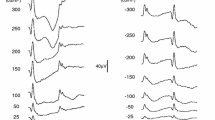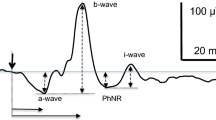Abstract
A visual response to flickering light requires complex retinal computation, and thus ERG measures are an excellent test of retinal circuit fidelity. Critical flicker frequency (CFF) is the frequency at which the retinal response is no longer modulated. Traditionally, CFF is obtained with a series of steady flicker stimuli with increasing frequencies. However, this method is slow and susceptible to experimental drift and/or adaptational effects. The current study compares the steady flicker method to CFF measurements obtained using a frequency sweep protocol. We introduce a light source programmed to produce a linear sweep of frequencies in a single trial. Using the traditional steady flicker method and a criterion response of 3 μV, we obtained a scotopic CFF of 18.4 ± 0.66 Hz and a photopic CFF of 44.4 ± 1.67 Hz. Our sweep flicker method, used on the same animals, produces a waveform best analyzed by Fourier transform; wherein a 6.18 log μV2 threshold was found to yield CFF values equal to those of the steady flicker method. Thus, the two flicker ERG techniques give comparable results, under both dark- and light-adapted conditions, and the flicker sweep method is faster to administer and analyze and may be less susceptible to blinking, breathing, and eye movement artifacts.
Access this chapter
Tax calculation will be finalised at checkout
Purchases are for personal use only
Similar content being viewed by others
References
Bowles KE, Kraft TW (2012) ERG critical flicker frequency assessment in humans. In: Retinal degenerative diseases LaVail et al (eds) Adv Exp Med Biol 723:503–509
Fishman GA, Birch DG, Holder GE et al (2001) Electrophysiologic testing in disorders of the retina, optic nerve, and visual pathway. In: American Academy Ophthalmology, 2nd edn, San Francisco, Oxford University Press
Frishman LJ, Wang MH (2011) Electroretinogram of human, monkey and mouse. In: Levin LA, Nilsson SFE, Ver Hoeve J et al (eds) Adler’s physiology of the eye, 11th edn. Saunders Elsevier, New York
Nowak LM, Green DG (1983) Flicker fusion characteristics of rod photoreceptors in the toad. Vis Res 23:845–849
Panilla I, Lund RD, Suavé Y (2005) Cone function studied with flicker electroretinogram during progressive retinal degeneration in RCS rats. Exp Eye Res 80:51–59
Pardue MT, Peachey NS (2014) Mouse b-wave mutants. Doc Ophthalmol 128:77–89
Rubin GR, Kraft TW (2007) Flicker assessment of rod and cone function in a model of retinal degeneration. Doc Ophthalmol 115:165–172
Tanimoto N, Muehlfriedel RL, Fischer MD et al (2009) Vision tests in the mouse: functional phenotyping with electroretinography. Front Biosci 14:2730–2737
Zhang Y, Rubin GR, Fineberg N et al (2012) Age-related changes in Cngb1-X1 knockout mice: prolonged cone survival. Doc Ophthalmol 124:163–175
Acknowledgments
We thank Alex Zotov for computational programming, Eric Wellington for fabrication of light bench components, and Wes Moore for fabrication of electrical components. This study was supported by an NIH grant EY023603 (TWK) and a core grant P30EY003039.
Author information
Authors and Affiliations
Corresponding author
Editor information
Editors and Affiliations
Rights and permissions
Copyright information
© 2018 Springer International Publishing AG, part of Springer Nature
About this paper
Cite this paper
DeRamus, M.L., Kraft, T.W. (2018). Optimizing ERG Measures of Scotopic and Photopic Critical Flicker Frequency. In: Ash, J., Anderson, R., LaVail, M., Bowes Rickman, C., Hollyfield, J., Grimm, C. (eds) Retinal Degenerative Diseases. Advances in Experimental Medicine and Biology, vol 1074. Springer, Cham. https://doi.org/10.1007/978-3-319-75402-4_18
Download citation
DOI: https://doi.org/10.1007/978-3-319-75402-4_18
Published:
Publisher Name: Springer, Cham
Print ISBN: 978-3-319-75401-7
Online ISBN: 978-3-319-75402-4
eBook Packages: Biomedical and Life SciencesBiomedical and Life Sciences (R0)




